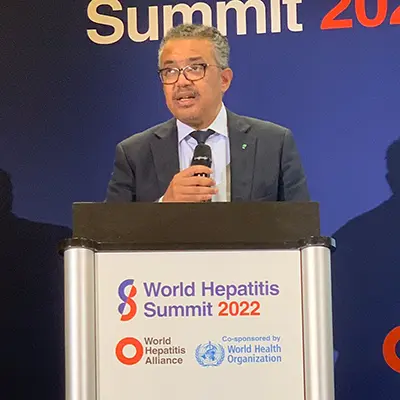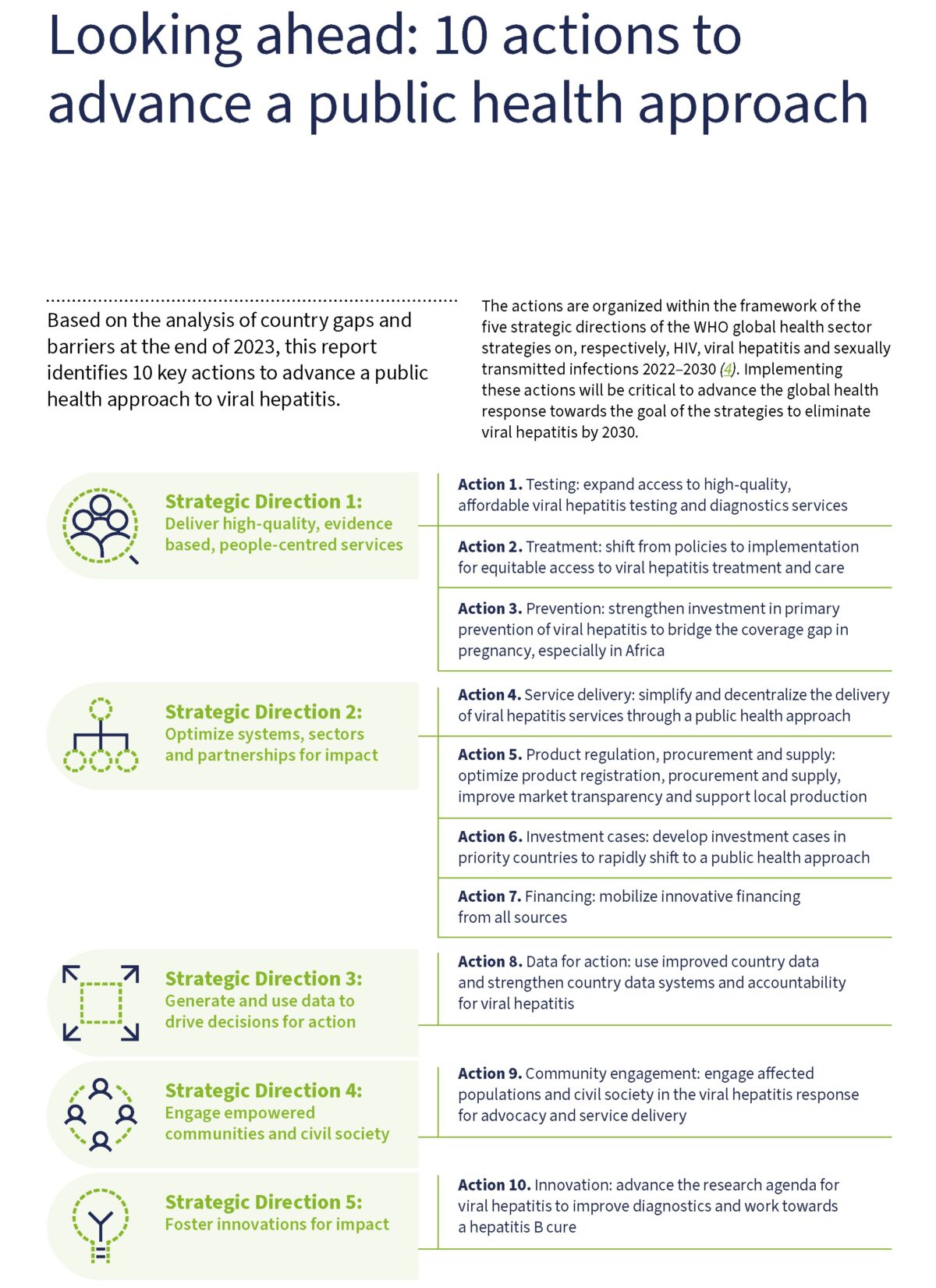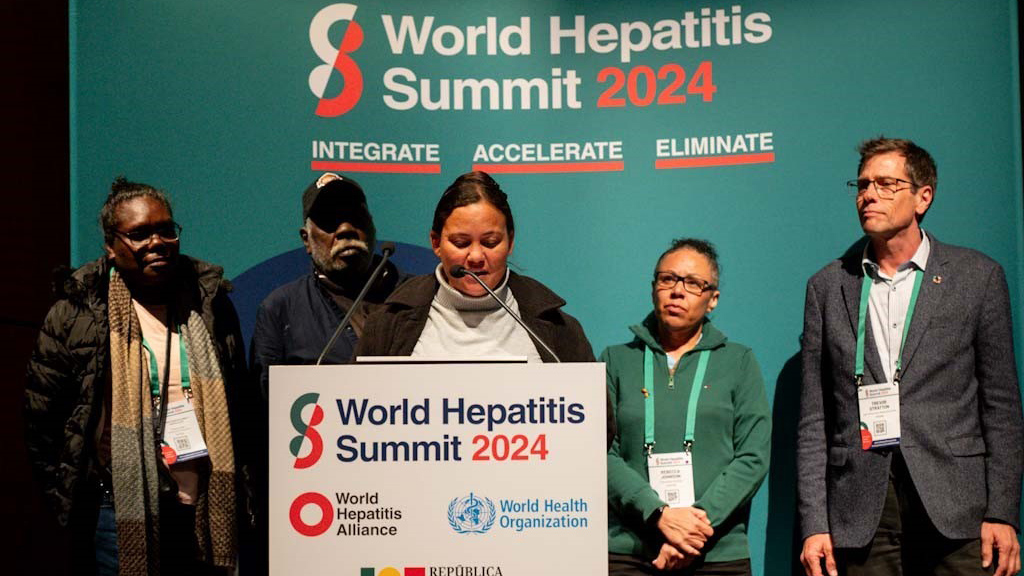In 2023, Dr Tedros Adhanom Ghebreyesus, Director-General of the World Health Organization (WHO), presented Egypt with an official certification for becoming the first country to achieve gold-tier status on the path to elimination for hepatitis C. “This is a tremendous achievement which could be within the reach of many other countries,” he said. “We have the knowledge and tools to prevent, diagnose and treat viral hepatitis, and the ability to deliver services at the primary health care level, closer to communities in need. Yet despite this progress, most people around the world with chronic hepatitis B and C are still waiting to access the services they need, and deaths are on the rise.”

Yesterday, the WHO launched the first consolidated global report on viral hepatitis at the World Hepatitis Summit in Lisbon, Portugal. It’s a call to action for a simplified and equitable public health approach to eliminate viral hepatitis. This is an eminently reachable goal! More countries are adopting WHO guidelines, developing national plans, and including viral hepatitis services in universal health care packages. Vaccines, rapid diagnostic tests and generic medicines are available at affordable prices, especially in countries like Australia where they are government-subsidised; and local production is making it possible to reach many more people. Affected communities are raising awareness, demanding access and advocating for change.
BRIEFLY
- Number of hepatitis deaths is increasing, making it the second leading cause of infectious diseases deaths, on par with tuberculosis, and second only to COVID-19.
- Despite better tools for diagnosis and treatment, and decreasing product prices, testing and treatment coverage rates have stalled.
- The burden of viral hepatitis varies regionally and despite availability of affordable generic viral hepatitis medicines, many countries fail to procure them at the lower prices.
- WHO proposes 10 steps for accelerating progress to elimination.
- Funding at global and country levels remain a challenge.
Nevertheless, the latest data show that, world-wide, viral hepatitis is one of the most significant public health challenges of this decade, and the world is still far from achieving its elimination by 2030, less than six years away. Combined, hepatitis B and C cause 3500 deaths per day, and this death rate is actually increasing. An estimated 254 million people are living with hepatitis B and 50 million people are living with hepatitis C worldwide, and each day there are 6000 people newly infected with one of these two life-changing viruses. Viral hepatitis is the second leading infectious cause of death globally, with 1.3 million deaths per year (the same as tuberculosis).

Many people remain undiagnosed in many countries, and even when hepatitis is diagnosed, the number of people receiving treatment remains incredibly low. Although medicines are available at affordable prices, many countries are still not taking full advantage of these treatments because of policy, programmatic and access barriers, not to mention prejudice against the various communities most at risk of contracting blood-borne viruses.
Similarly, many infants do not receive the hepatitis B birth dose vaccination along with at least two additional recommended doses, as mandated in Australia (see our previous post), despite the low cost of this intervention. Funding for viral hepatitis remains limited: around the world viral hepatitis accounts for nearly eight times as many prevalent infections as HIV, and yet the viral hepatitis response has less than 10% of the funding.
The report gathers new data from 187 countries to show that the estimated number of deaths from viral hepatitis increased from 1.1 million in 2019 to 1.3 million in 2022. Of these, 83 per cent were caused by hepatitis B, and 17 per cent by hepatitis C. “This report paints a troubling picture: despite progress globally in preventing hepatitis infections, deaths are rising because far too few people with hepatitis are being diagnosed and treated,” said Dr Ghebreyesus. “WHO is committed to supporting countries to use all the tools at their disposal, at access prices, to save lives and turn this trend around.”
Updated WHO estimates indicate that half the burden of chronic hepatitis B and C infections is among people 30–54 years old, with 12 per cent among children under 18 years of age. Men account for 58 per cent of all cases. Across all regions, only 13 per cent of people living with chronic hepatitis B infection had been diagnosed and approximately 3 per cent (7 million) had received antiviral therapy at the end of 2022. Regarding hepatitis C, 36 per cent had been diagnosed and 20 per cent (12.5 million) had received curative treatment.
These results fall well below the global targets to treat 80 per cent of people living with chronic hepatitis B and hepatitis C by 2030. However, they do indicate slight but consistent improvement in diagnosis and treatment coverage since the last reported estimates in 2019. Specifically, hepatitis B diagnosis increased from 10 per cent to 13 per cent and treatment from 2 per cent to 3 per cent, and hepatitis C diagnosis from 21 per cent to 36 per cent and treatment from 13 per cent to 20 per cent.

The burden of viral hepatitis varies regionally. The WHO African Region bears 63 per cent of new hepatitis B infections, yet despite this burden, only 18 per cent of newborns in the region receive the hepatitis B birth-dose vaccination. In the Western Pacific Region, which accounts for 47 per cent of hepatitis B deaths, treatment coverage stands at 23 per cent among people diagnosed, which is far too low to reduce mortality.
Bangladesh, China, Ethiopia, India, Indonesia, Nigeria, Pakistan, the Philippines, the Russian Federation and Vietnam collectively shoulder nearly two-thirds of the global burden of hepatitis B and C. Achieving universal access to prevention, diagnosis, and treatment in these ten countries by next year, alongside intensified efforts in the African Region, is essential to get the global response back on track to meet the Sustainable Development Goals.
Despite the availability of affordable generic viral hepatitis medicines, many countries fail to procure them at these lower prices. For example, although tenofovir for treatment of hepatitis B is off patent and available at a global benchmark price of US$2.40 per month, only 7 of the 26 reporting countries paid prices at or below the benchmark. Similarly, a 12-week course of pangenotypic sofosbuvir/daclatasvir to treat hepatitis C is available at a global benchmark price of US$60, yet only 4 of 24 reporting countries paid prices at or below the benchmark. Service delivery remains centralised and vertical, and many affected populations still face out-of-pocket expenses for viral hepatitis services.
Only 60 per cent of reporting countries offer viral hepatitis testing and treatment services free of charge, either entirely or partially, in the public sector. Financial protection is lower in the African Region, where only about one third of reporting countries provide these services free of charge.
Recommendations for accelerating hepatitis elimination
The report outlines a series of actions to advance a public health approach to viral hepatitis, designed to accelerate progress towards ending the epidemic by 2030. They include:
- expanding access to testing and diagnostics;
- shifting from policies to implementation for equitable treatment;
- strengthening primary care prevention efforts;
- simplifying service delivery, optimising product regulation and supply;
- developing investment cases in priority countries;
- mobilising innovative financing;
- using improved data for action; and
- engaging affected communities and civil society and advancing research for improved diagnostics and potential cures for hepatitis B.







